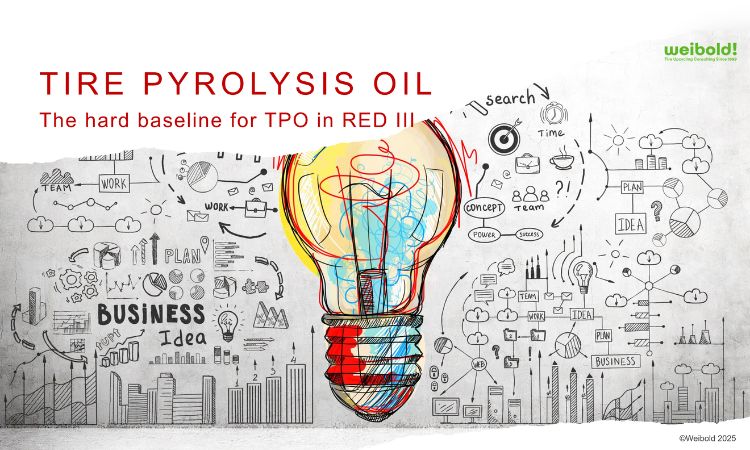Weibold Academy: RED III redefines the future of tire pyrolysis oil in Europe
Weibold Academy article series discusses periodically the practical developments and scientific research findings in the end-of-life tire (ELT) recycling and pyrolysis industry.

These articles are reviews by Claus Lamer – the senior pyrolysis consultant at Weibold. The reviews aim to give industry entrepreneurs, project initiators, investors, and the public a better insight into a rapidly growing circular economy. At the same time, this article series should stimulate discussion.
For completeness, we would like to emphasize that these articles are no legal advice from Weibold or the author. Please refer to the responsible authorities and specialist lawyers for legally binding statements.
Policy Is Powering the Tire-Pyrolysis-Oil (TPO) Market
When Europe adopted the Renewable Energy Directive III (RED III) in June 2023, few outside the energy policy sphere anticipated how consequential the reform would be for niche industries. Yet, for producers of Tire-Derived Pyrolysis Oil (TPO), RED III is more than legislative housekeeping; it's a turning point that transforms a once-marginal circular fuel into a recognized contributor to Europe's decarbonization ambitions.
RED III, which replaces its predecessor RED II as of mid-2025, aims to accelerate the EU's path toward climate neutrality by tightening sustainability criteria, expanding eligible fuel categories, and raising greenhouse gas (GHG) savings thresholds. Among the most impacted are producers of low-carbon fuels derived from waste, including those using End-of-Life Tires (ELTs) as feedstock.
This article explores the significant implications of RED III for TPO producers, particularly those seeking certification under the International Sustainability and Carbon Certification (ISCC EU) scheme. It outlines the benefits, compliance hurdles, and strategic opportunities embedded in the new regulatory framework.
A New Legal Identity for Tire Pyrolysis Oil
Under RED II, tire pyrolysis oil (TPO) occupied an ambiguous legal space. While its biogenic content (from natural rubber in tires) could theoretically qualify as a renewable component, the fossil-derived portion (from synthetic rubber) was left in limbo, often disqualified from energy target contributions. RED III eliminates this uncertainty.
The directive now classifies the biogenic portion of TPO as an advanced biofuel, aligning it with Annex IX Part A feedstocks that benefit from dedicated quotas and multipliers. More significantly, RED III introduces a formal category for Recycled Carbon Fuels (RCFs). The fossil fraction of TPO, once disregarded in energy accounting, is now eligible to contribute to national climate targets—provided it achieves at least 70% GHG savings compared to the fossil baseline.
This dual recognition is a game-changer. It opens up new compliance markets for TPO and encourages investment by validating its role in meeting the EU's ambitious climate goals.
A New Compliance Landscape for Producers
For TPO producers aiming to supply the EU market, ISCC EU certification remains the gold standard. But under RED III, the certification process becomes more demanding.
First, all TPO consignments must now undergo precise biogenic content testing. Using radiocarbon (C-14) analysis, producers must determine what proportion of the oil is derived from natural rubber. This figure is not merely academic—it defines whether the product qualifies as an advanced biofuel, a recycled carbon fuel, or a combination of both.
Second, GHG emissions accounting has become stricter. The previous threshold of 60% GHG savings is no longer sufficient. RED III mandates:
- ≥70% GHG savings for RCFs
- ≥65% GHG savings for advanced biofuels from new installations
These calculations must account for all stages of the fuel’s life cycle, including feedstock collection, processing, transportation, and combustion.
The Union Database: Digital Traceability Comes of Age
In a bid to enhance transparency and prevent fraud, RED III introduces the Union Database (UDB). This central EU system will record all transactions of biofuels, RCFs, and related renewable energy carriers.
For TPO producers, this means that every certified consignment must be digitally logged, including:
Feedstock origin (country, waste classification) Biogenic and fossil fractions GHG performance values Chain-of-custody documentation
Compliance will require seamless integration of internal mass balance systems with external reporting frameworks—producers who fail to adapt risk exclusion from valuable EU markets.
New Market Opportunities—and Responsibilities
With RED III, TPO's market value extends beyond road fuels. The directive introduces incentives for sectors like maritime and aviation, where decarbonization is particularly challenging.
Advanced biofuels used in shipping, for example, may be subject to 1.2x energy multipliers when calculating compliance contributions. When coupled with the standard 2x multiplier for Annex IX Part A fuels, this can create significant commercial upside. A TPO blend with 30% biogenic content could theoretically yield 2.4x credit per unit of energy supplied.
However, these benefits come with heightened scrutiny. Producers must be able to distinguish and document:
- Which portion of their output is advanced biofuel
- Which portion is RCF
- The exact GHG savings associated with each
Failing to delineate these properties could result in partial or total disqualification from compliance schemes.
Chemical Feedstock: A Parallel Path
While RED III focuses on energy targets, its influence will spill into the chemical sector. Crackers and petrochemical plants are under increasing pressure to decarbonize, and TPO presents a dual benefit: renewable carbon from biogenic fractions and circular carbon from fossil-derived components.
ISCC PLUS certification may be required for producers targeting this segment. Although not tied to RED III targets, it enables credible claims about sustainable or circular content in plastics and other materials. Some European chemical giants are already sourcing ISCC-certified pyrolysis oil for this purpose.
This dual-certification strategy, ISCC EU for energy, ISCC PLUS for materials, is emerging as the best practice among forward-looking TPO producers.
Audit Pressure and Strategic Preparation
From September 2025, ISCC EU audits will be conducted under complete RED III alignment. That includes new checklists covering:
- GHG methodology (aligned with Delegated Regulation EU 2023/1185)
- Verification of waste feedstock origin
- Supplier declarations and self-audits
- Compatibility with the Union Database interface
TPO producers will need to upgrade their internal systems and possibly retrain personnel. Those already certified under ISCC PLUS may find the transition smoother, as many structural elements (e.g., mass balance, document control) overlap. But RED III raises the bar across the board.
Conclusion: A New Era of Circular Fuels
RED III marks a profound shift in how Europe views—and regulates—low-carbon fuels made from waste. For TPO producers, the directive is both an invitation and a challenge.
On the one hand, RED III legitimizes tire-derived oil as a serious climate solution, granting access to compliance markets that were previously out of reach. On the other hand, it demands rigorous certification, data accuracy, and continuous GHG performance improvement.
For those prepared to meet the new standards, the payoff is clear: access to a regulated, expanding, and increasingly valuable European market hungry for circular, traceable, and climate-smart fuels.
If you would like to gain deeper insights into this topic, please don't hesitate to contact the author, claus@weibold.com.
Weibold is an international consulting company specializing exclusively in end-of-life tire recycling and pyrolysis. Since 1999, we have helped companies grow and build profitable businesses.











